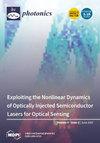Cooperative Terrestrial–Underwater FSO System: Design and Performance Analysis
IF 1.9
4区 物理与天体物理
Q2 OPTICS
引用次数: 0
Abstract
In this paper, we propose, design, and evaluate a new hybrid terrestrial–underwater optical communication link for providing high-speed connectivity between land and underwater systems. A device based on an amplify-and-forward strategy is considered and used for the hybrid optical link. A performance analysis of the proposed hybrid system is then carried out, taking into account both the atmospheric and underwater channels and their respective degradation sources. Different networking scenarios and conditions are evaluated. To this end, the channel model of the terrestrial free-space optical (FSO) link is modeled using the Gamma–Gamma distribution, while the underwater optical link is modeled using the Weibull distribution. The former takes into account atmospheric and turbulence attenuation, geometric spread and pointing errors, while the latter takes into account underwater and turbulence attenuation and geometric spread. Accordingly, a new analytical closed-form expression for the bit error rate (BER), which depends on the cumulative distribution function of the holistic hybrid system, is derived. Analytical results show that pointing errors as well as atmospheric and oceanic turbulence seriously degrade the performance of the hybrid system. In addition, ocean turbulence leads to the occurrence of a BER floor in some scenarios. This is the first time that such a network is proposed and modeled under the assumption of critical channel impairments.地面-水下合作 FSO 系统:设计与性能分析
本文提出、设计并评估了一种新型陆地-水下混合光通信链路,用于提供陆地和水下系统之间的高速连接。混合光链路考虑并使用了一种基于放大-前向策略的设备。然后,考虑到大气和水下信道及其各自的衰减源,对拟议的混合系统进行了性能分析。对不同的联网场景和条件进行了评估。为此,地面自由空间光学(FSO)链路的信道模型采用伽马-伽马分布建模,而水下光学链路则采用威布尔分布建模。前者考虑了大气和湍流衰减、几何扩散和指向误差,后者则考虑了水下和湍流衰减以及几何扩散。因此,得出了一个新的误码率(BER)分析闭式表达式,它取决于整体混合系统的累积分布函数。分析结果表明,指向误差以及大气和海洋湍流会严重降低混合系统的性能。此外,海洋湍流还导致某些情况下出现误码率下限。这是在关键信道损伤假设下首次提出这种网络并对其进行建模。
本文章由计算机程序翻译,如有差异,请以英文原文为准。
求助全文
约1分钟内获得全文
求助全文
来源期刊

Photonics
Physics and Astronomy-Instrumentation
CiteScore
2.60
自引率
20.80%
发文量
817
审稿时长
8 weeks
期刊介绍:
Photonics (ISSN 2304-6732) aims at a fast turn around time for peer-reviewing manuscripts and producing accepted articles. The online-only and open access nature of the journal will allow for a speedy and wide circulation of your research as well as review articles. We aim at establishing Photonics as a leading venue for publishing high impact fundamental research but also applications of optics and photonics. The journal particularly welcomes both theoretical (simulation) and experimental research. Our aim is to encourage scientists to publish their experimental and theoretical results in as much detail as possible. There is no restriction on the length of the papers. The full experimental details must be provided so that the results can be reproduced. Electronic files and software regarding the full details of the calculation and experimental procedure, if unable to be published in a normal way, can be deposited as supplementary material.
 求助内容:
求助内容: 应助结果提醒方式:
应助结果提醒方式:


